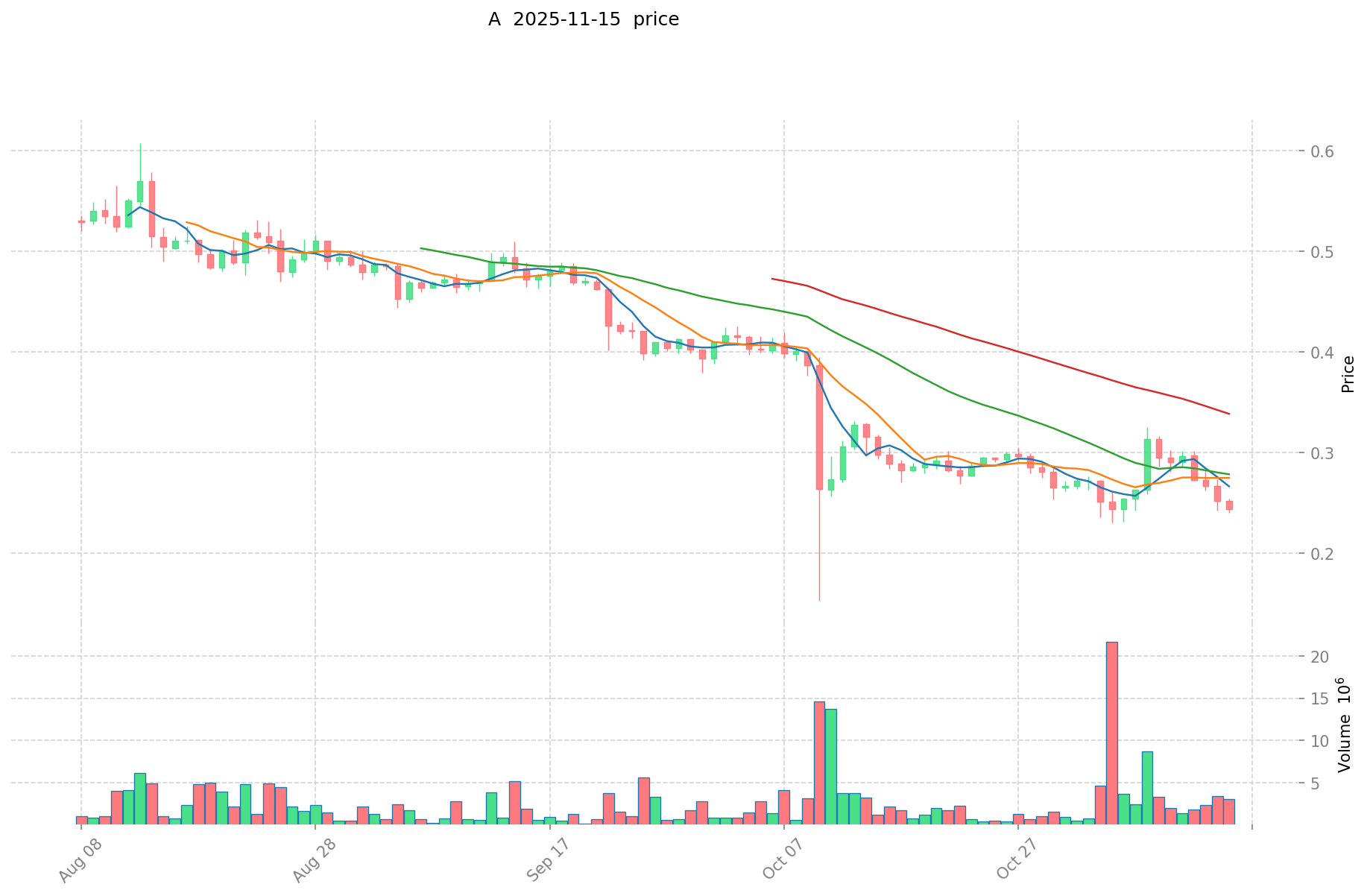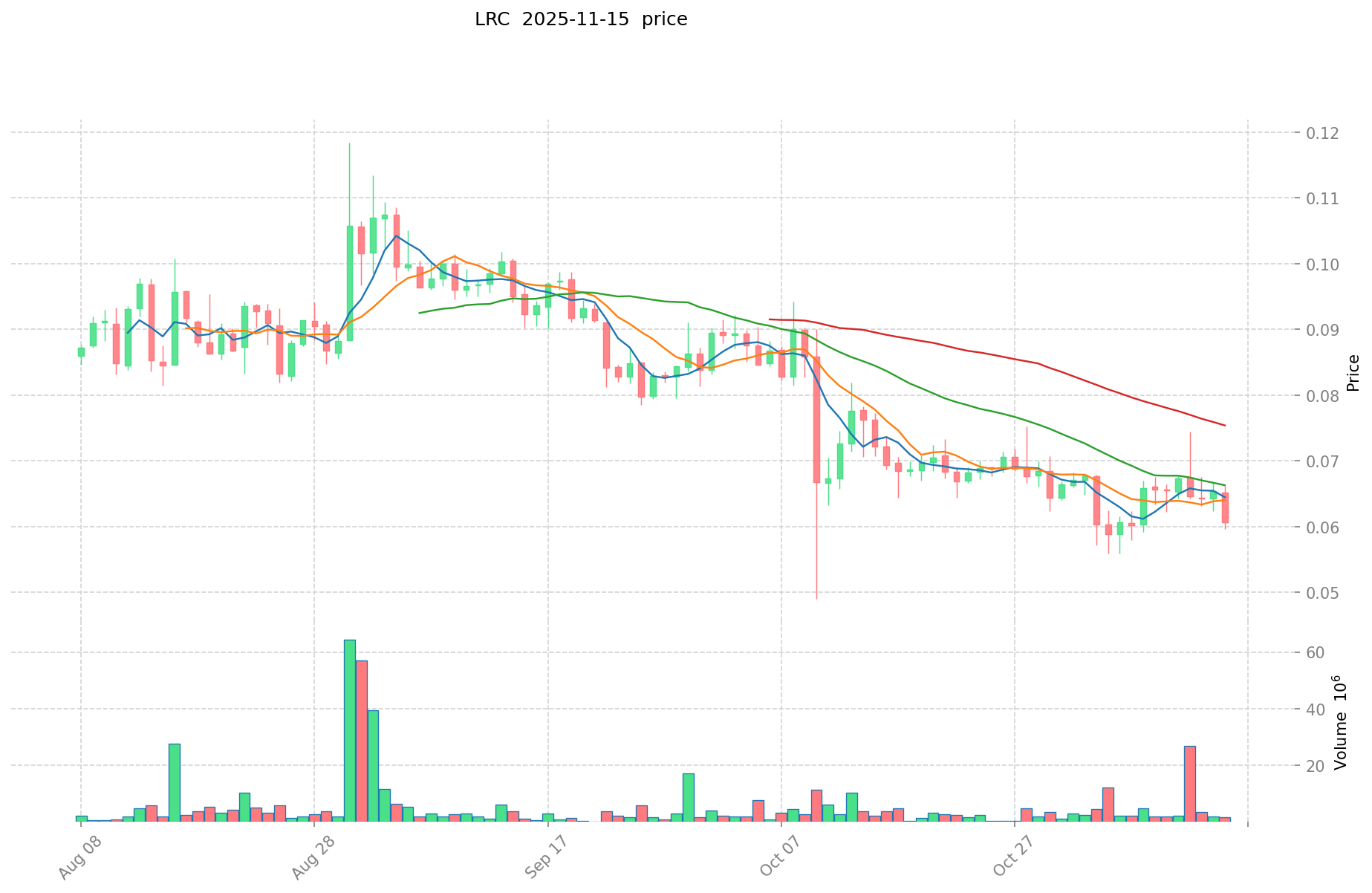A vs LRC: Comparing Audio Formats for Optimal Sound Quality and File Management
Introduction: Investment Comparison of A vs LRC
In the cryptocurrency market, the comparison between Vaulta vs Loopring has been an unavoidable topic for investors. The two not only differ significantly in market cap ranking, application scenarios, and price performance, but also represent different positioning in the crypto asset space.
Vaulta (A): Since its launch, it has gained market recognition for its position as a Web3 banking network empowering the next frontier of finance.
Loopring (LRC): Launched in 2017, it has been hailed as an open multi-token transaction protocol based on ERC20 and smart contracts, providing a zero-risk token exchange model.
This article will provide a comprehensive analysis of the investment value comparison between Vaulta vs Loopring, focusing on historical price trends, supply mechanisms, institutional adoption, technical ecosystems, and future predictions, attempting to answer the question investors care about most:
"Which is the better buy right now?"
I. Price History Comparison and Current Market Status
A (Coin A) and LRC (Coin B) Historical Price Trends
- 2025: A reached its all-time high of $0.778734 on May 28, 2025, and hit its all-time low of $0.210085 on October 11, 2025.
- 2021: LRC reached its all-time high of $3.75 on November 10, 2021.
- Comparative Analysis: In the current market cycle, A has dropped from its high of $0.778734 to its current price of $0.2457, while LRC has fallen from its peak of $3.75 to $0.06046.
Current Market Situation (2025-11-15)
- A current price: $0.2457
- LRC current price: $0.06046
- 24-hour trading volume: A $530,310.418418 vs LRC $122,564.6902851
- Market Sentiment Index (Fear & Greed Index): 10 (Extreme Fear)
Click to view real-time prices:
- View A current price Market Price
- View LRC current price Market Price


II. Core Factors Affecting the Investment Value of Loopring vs LRC
Supply Mechanism Comparison (Tokenomics)
- Loopring (LRC): LRC has a maximum supply cap of 1,374,513,896 tokens, with a deflationary mechanism where a portion of trading fees are used to buy back and burn LRC.
- 📌 Historical Pattern: Deflationary tokenomics have historically supported price stability during market downturns and amplified growth during bull markets.
Institutional Adoption and Market Applications
- Institutional Holdings: LRC has seen limited institutional adoption compared to larger Layer-1 tokens, though its zkRollup technology has attracted technical interest.
- Enterprise Adoption: Loopring's focus on decentralized exchanges and payment applications shows promise, particularly with its low gas fees and high throughput capabilities.
- Regulatory Attitudes: Loopring, as a Layer-2 scaling solution, generally faces less regulatory scrutiny than Layer-1 blockchains, though DEX regulations could impact adoption.
Technical Development and Ecosystem Building
- Loopring Technical Upgrades: Implementation of zkRollup technology provides significant scalability benefits, with transaction speeds up to 2,025 TPS and significantly reduced gas fees.
- Ecosystem Comparison: Loopring has established a growing ecosystem focused on DEX functionality, non-custodial trading, and payment solutions, though its ecosystem remains smaller than major Layer-1 networks.
Macroeconomic Factors and Market Cycles
- Performance in Inflationary Environments: As a utility token backing a scaling solution, LRC's value is more tied to Ethereum adoption and usage than to inflation hedging.
- Macroeconomic Monetary Policy: Interest rates and USD index changes affect LRC similarly to most crypto assets, with risk-off environments typically leading to decreased investment.
- Geopolitical Factors: Increasing demand for censorship-resistant and low-cost transaction solutions could benefit Layer-2 solutions like Loopring, particularly in regions with currency controls or high remittance costs.
III. 2025-2030 Price Prediction: A vs LRC
Short-term Prediction (2025)
- A: Conservative $0.125817 - $0.2467 | Optimistic $0.2467 - $0.291106
- LRC: Conservative $0.0497904 - $0.06072 | Optimistic $0.06072 - $0.0734712
Mid-term Prediction (2027)
- A may enter a growth phase, with an estimated price range of $0.251693208 - $0.3995629677
- LRC may enter a stable phase, with an estimated price range of $0.05476342872 - $0.07396618944
- Key drivers: Institutional capital inflow, ETF, ecosystem development
Long-term Prediction (2030)
- A: Base scenario $0.297013675365353 - $0.412518993562991 | Optimistic scenario $0.412518993562991 - $0.43314494324114
- LRC: Base scenario $0.06035481462026 - $0.095801293048032 | Optimistic scenario $0.095801293048032 - $0.106339435283315
Disclaimer
A:
| 年份 | 预测最高价 | 预测平均价格 | 预测最低价 | 涨跌幅 |
|---|---|---|---|---|
| 2025 | 0.291106 | 0.2467 | 0.125817 | 0 |
| 2026 | 0.36033002 | 0.268903 | 0.21781143 | 9 |
| 2027 | 0.3995629677 | 0.31461651 | 0.251693208 | 28 |
| 2028 | 0.4249367892315 | 0.35708973885 | 0.3320934571305 | 45 |
| 2029 | 0.434024723085232 | 0.39101326404075 | 0.348001804996267 | 59 |
| 2030 | 0.43314494324114 | 0.412518993562991 | 0.297013675365353 | 67 |
LRC:
| 年份 | 预测最高价 | 预测平均价格 | 预测最低价 | 涨跌幅 |
|---|---|---|---|---|
| 2025 | 0.0734712 | 0.06072 | 0.0497904 | 0 |
| 2026 | 0.075147072 | 0.0670956 | 0.042941184 | 10 |
| 2027 | 0.07396618944 | 0.071121336 | 0.05476342872 | 17 |
| 2028 | 0.1073647688256 | 0.07254376272 | 0.0558586972944 | 19 |
| 2029 | 0.101648320323264 | 0.0899542657728 | 0.080059296537792 | 48 |
| 2030 | 0.106339435283315 | 0.095801293048032 | 0.06035481462026 | 58 |
IV. Investment Strategy Comparison: A vs LRC
Long-term vs Short-term Investment Strategy
- A: Suitable for investors focused on Web3 banking and financial innovation
- LRC: Suitable for investors interested in Layer-2 scaling solutions and DEX technology
Risk Management and Asset Allocation
- Conservative investors: A: 30% vs LRC: 70%
- Aggressive investors: A: 60% vs LRC: 40%
- Hedging tools: Stablecoin allocation, options, cross-currency portfolios
V. Potential Risk Comparison
Market Risk
- A: Higher volatility due to newer market entry and smaller market cap
- LRC: Dependent on Ethereum ecosystem growth and Layer-2 adoption rates
Technical Risk
- A: Scalability, network stability
- LRC: Smart contract vulnerabilities, zkRollup technology risks
Regulatory Risk
- Global regulatory policies may impact both differently, with A potentially facing more scrutiny as a newer project
VI. Conclusion: Which Is the Better Buy?
📌 Investment Value Summary:
- A advantages: Positioning in Web3 banking, potential for rapid growth
- LRC advantages: Established Layer-2 solution, lower fees, higher transaction speed
✅ Investment Advice:
- New investors: Consider a balanced approach, leaning towards LRC for its more established presence
- Experienced investors: Explore A for higher growth potential, maintain LRC for ecosystem exposure
- Institutional investors: Diversify between both, with a larger allocation to LRC for its more proven technology
⚠️ Risk Warning: The cryptocurrency market is highly volatile. This article does not constitute investment advice. None
VII. FAQ
Q1: What are the main differences between A and LRC? A: A is positioned as a Web3 banking network, while LRC is a Layer-2 scaling solution for Ethereum focusing on decentralized exchanges. A is newer with potentially higher growth, while LRC has a more established presence in the crypto ecosystem.
Q2: Which token has performed better in terms of price history? A: LRC reached a higher all-time high of $3.75 in November 2021, compared to A's all-time high of $0.778734 in May 2025. However, both have experienced significant drops from their peaks.
Q3: How do the supply mechanisms of A and LRC differ? A: LRC has a maximum supply cap of 1,374,513,896 tokens with a deflationary mechanism where trading fees are used to buy back and burn tokens. A's specific supply mechanism is not detailed in the given information.
Q4: What are the key factors affecting the investment value of A and LRC? A: Key factors include institutional adoption, technical development, ecosystem building, macroeconomic factors, and regulatory attitudes. LRC benefits from its established Layer-2 technology, while A's value is tied to the growth of Web3 banking.
Q5: What are the price predictions for A and LRC by 2030? A: By 2030, A is predicted to reach $0.297013675365353 - $0.43314494324114, while LRC is expected to reach $0.06035481462026 - $0.106339435283315 in base to optimistic scenarios.
Q6: How should investors allocate their assets between A and LRC? A: Conservative investors might consider 30% A and 70% LRC, while aggressive investors might opt for 60% A and 40% LRC. The exact allocation depends on individual risk tolerance and investment goals.
Q7: What are the main risks associated with investing in A and LRC? A: Both face market risks due to crypto volatility. A may have higher technical risks due to being newer, while LRC faces risks related to Ethereum ecosystem dependence and Layer-2 adoption rates. Both also face potential regulatory risks, with A possibly facing more scrutiny as a newer project.
Share
Content